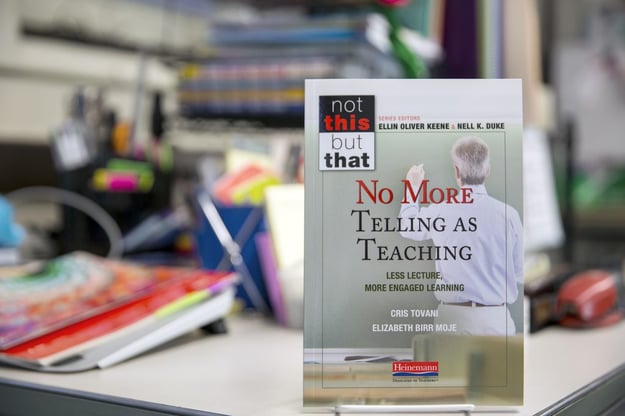
Adapted from No More Telling as Teaching: Less Lecture, More Engaged Learning by Cris Tovani and Elizabeth Birr Moje.
Why should we care about whether teachers rely on lecture? People have lectured throughout history, and many teachers claim this is the most efficient way to cover content. And, in fact, in and of itself the lecture is not a bad method for sharing information, ideas, or perspectives. Many people share their thoughts with others through lectures.
Because learners can participate in well-framed and well-structured lectures for which they have a clear sense of purpose, it is not the lecture that we challenge but rather a conception of learning that makes the teacher the knowledge disseminator and the students receptacles waiting to be filled. Specifically, we challenge the steady diet of teachers and textbooks (or other media) telling, with students regurgitating what they have been told.
The problem with lecture arises with the idea that the only way for students to learn is for the teacher to engage in what Sizer (1984) referred to as the “pedagogy of telling” or what we refer to as stand-and-deliver pedagogy. In other words, the problem with lecture-only teaching lies in thinking that teaching equals telling and that learning is equivalent to a bank deposit (for more on “banking education,” see Freire [1970]) in which teachers tell students information and students deposit the information in the vaults of their brains. Humans do store information, but not in a passive way. People connect new information to existing conceptually organized mental structures, sometimes called schema (Anderson and Pearson 1984) or networks (Rumelhart et al. 1986). These mental structures become more and more powerful as new connections are built and reinforced through experience.
Moreover, in today’s world, students need a wider range of skills than being effective at receiving new information. That skill had greater value when the world was a more static place, but today, in a rapidly changing economy and culture, people need to be able to communicate effectively to collaborate across different backgrounds and experiences if they are to solve the complex problems of today’s world. It is not just the speed of communication via technology that demands these skills, but also the pace of discovery and change. To be effective and informed, people need to be able to navigate, assess, and respond to the onslaught of new information, ideas, and perspectives. Content is valuable, but it is not enough. People need also to develop skills and practices for engaging with other people, with ideas, and with new tools and technologies.
The development of these conceptual understandings and meaning-making skills is more serious and more difficult to achieve than a “college- and career-ready” mantra might suggest. Educators have always sought to produce students who are more than receptacles of information, but schools have not always offered the necessary learning opportunities to support that goal; if the goal is for all students to learn to be critical readers, writers, and thinkers and thus productive and generative citizens, then teachers, school leaders, and policymakers need to understand effective practices for helping them learn these skills. And the available evidence shows that a lecture-only—or stand-and-deliver—method is not the most useful for ensuring that students not only take in, but also retain, retrieve, use, and construct new ideas.
♦ ♦ ♦
To find out more about the research on how people learn best, as well as practical advice on how to put that research to use in your classroom, check out No More Telling as Teaching: Less Lecture, More Engaged Learning by Cris Tovani and Elizabeth Birr Moje. You can download a sample chapter here.
♦ ♦ ♦
Anderson, R. C., and P. D. Pearson. 1984. “A Schema-Theoretic View of Basic Processes in Reading Comprehension.” In Handbook of Reading Research, Vol. II, edited by P. D. Pearson, R. Barr, M. L. Kamil, and P. Mosenthal, 225–53. New York: Longman
Freire, P. 1970. Pedagogy of the Oppressed. New York: Continuum.
Rumelhart, D. 1994. “Toward an Interactive Model of Reading.” In Theoretical Models and Processes of Reading, 4th ed., edited by R. B. Ruddel, M. R. Ruddell, and H. Singer, 864–94. Newark, DE: International Reading Association.
Sizer, T. R. 1984. Horace’s Compromise: The Dilemma of the American High School. Boston: Houghton Mifflin.


